
For much of the 20th century, asbestos was a go-to material in the UK. It was valued for durability, low cost, and strong resistance to fire and heat. Once promoted as a “miracle product,” asbestos is now recognised as a major health hazard.
The best-known asbestos colours are blue, brown, and white which are the forms most widely found in UK buildings. These asbestos types and colours relate to separate mineral families and so the health risks differ between them.
In Part 1 of this two-part blog series, we answer the question “how many common types of asbestos were available?” by introducing the three main types and explaining why identifying asbestos types and colours is important. In Part 2, we will dive deeper into blue, brown, and white asbestos, exploring their characteristics, and why each is considered hazardous.
What are asbestos colours?
Asbestos fibres occur naturally in a range of colours, the most common being blue, brown, and white because they are cheap and easy to source. Less common asbestos colours such as grey, green, pink, and yellow were also used in the UK.
The colour of asbestos can give an indication of the type, as each variety belongs to a different mineral group. Chrysotile (white asbestos) comes from the serpentine group, while amosite (brown) and crocidolite (blue) are part of the amphibole group. This mineral structure influences fibre shape, strength, and level of health risk.
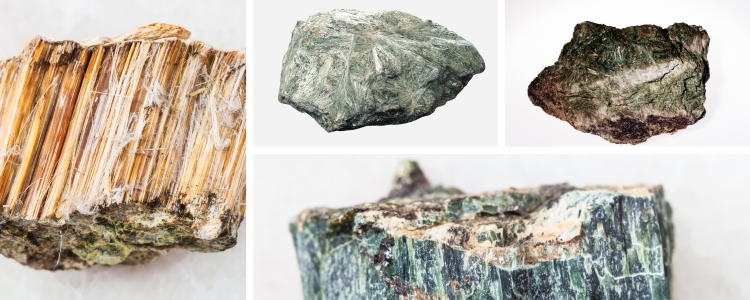
How many types of asbestos are there?
Asbestos is not a single substance but a group of naturally occurring minerals. In total, there are six recognised types of asbestos, split into two mineral families:
Amphibole family
Amphibole fibres are straight, stiff, and needle-like, which makes them especially dangerous when inhaled. Their sharp shape means they can pierce deep into lung tissue and the pleura (the lining of the lungs), where they become lodged.
- Amosite – known as brown asbestos.
- Crocidolite – known as blue asbestos.
- Tremolite – sometimes described as green asbestos when found in deposits.
- Actinolite – also referred to as green asbestos in some contexts.
- Anthophyllite – sometimes called grey asbestos.
Serpentine family
Serpentine fibres are curly, soft and flexible which means they are less likely to penetrate deep into the lungs and may be broken down by the body more easily than the sharp, needle-like amphibole fibres.
- Chrysotile – known as white asbestos (the only serpentine type).
In addition to the six recognised minerals, asbestos has sometimes been described by other colours. These were not distinct mineral types but rather variants or trade names:
- Pink asbestos – thought to be a variant of chrysotile or a blend of fibres developed for fire-resistant insulation.
- Yellow asbestos – a very rare iron-rich variant (usually of tremolite or actinolite), occasionally used in specialist high-temperature insulation.
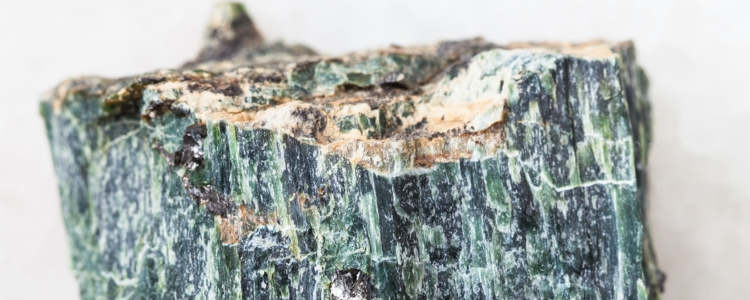
The 3 main asbestos types (by colour)
There are 3 main types of asbestos that were commonly used in the UK. In Part 2 of this blog series, we take a more detailed look at the asbestos types below, looking at their properties, historical uses and health risks, and how to manage each type safety.
Crocidolite (blue asbestos)
Crocidolite, often referred to as blue asbestos, belongs to the amphibole mineral group. Crocidolite was valued for its strong chemical and heat resistance, often used in insulation and cement products.
As an amphibole, crocidolite’s sharp, fine, straight fibres remain in the lungs and are strongly linked to mesothelioma, an aggressive cancer of the lung lining, as well as lung cancer, asbestosis and pleural thickening. Crocidolite is therefore the most hazardous form of asbestos.
Amosite/grunerite (brown asbestos)
Amosite, known as brown asbestos, is another amphibole type. It was widely used in ceiling tiles, insulation boards, and thermal lagging.
Amosite is considered less dangerous than crocidolite because it has thicker and straighter fibres which are less aerodynamic. This means they are not as easily inhaled into the deepest parts of the lungs as the very fine, sharp fibres of crocidolite. Once inhaled, however, amosite fibres remain lodged in lung tissue, and can cause mesothelioma, lung cancer and asbestosis.
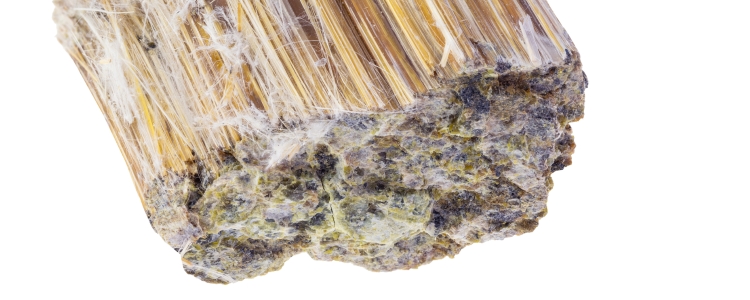
Chrysotile (white asbestos)
Chrysotile, or white asbestos, comes from the serpentine group so its fibres are curly, soft, and flexible. This made chrysotile easier to weave and incorporate into construction materials such as roofing sheets, cement, gaskets, and brake linings.
Chrysotile is considered less dangerous than amphibole asbestos types because the curly fibres are less likely to penetrate deep into the lungs and may be broken down by the body more easily than the sharp, needle-like amphibole fibres. However, this does not mean it is safe. Chrysotile was by far the most widely used type of asbestos in the UK, so the scale of exposure was far greater than with blue or brown asbestos.
Even though chrysotile fibres may not lodge as deeply in the lungs as amphiboles, continuous or heavy exposure can still lead to asbestosis, lung cancer, mesothelioma and pleural thickening.
Other asbestos types and colours
While blue, brown, and white asbestos were the three main types used in the UK, several rarer forms also exist. These were either used in specialist applications or entered products accidentally as contaminants in other minerals.
Actinolite (green asbestos)
Actinolite was not widely used in the UK as a primary material. However, it occasionally appeared in insulation, sealants, cement products, and paints unintentionally because it is a natural contaminant in chrysotile (white asbestos) deposits. When chrysotile was mined, veins of actinolite often occurred alongside it in the same rock formations.
Actinolite is an amphibole with sharp, brittle fibres which can cause asbestosis, mesothelioma, lung cancer, and pleural thickening.
Tremolite (green asbestos)
Tremolite is considered one of the most concerning rare asbestos types because it frequently occurred as a natural contaminant in talc and vermiculite deposits.
When mined, asbestos-bearing seams could mix with talc or vermiculite, leading to contaminated products such as talcum powders, cosmetics, paints, sealants, and insulation materials.
A well-known example is the talc scandal, where asbestos contamination in consumer products led to lawsuits against manufacturers, including Johnson & Johnson, highlighting that asbestos risks were not limited to industrial settings.
Tremolite is an amphibole with thin, needle-like fibres. It has strong links to lung cancer, mesothelioma, pleural thickening, and asbestosis.
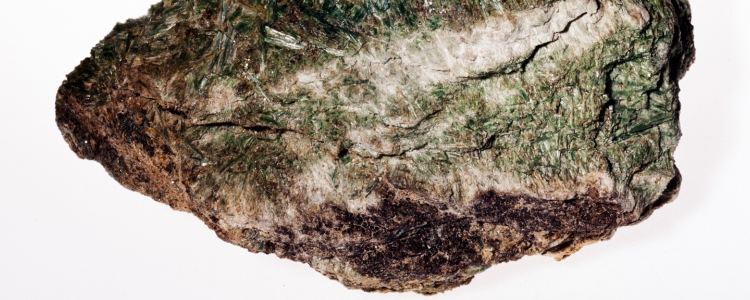
Anthophyllite (grey asbestos)
Anthophyllite was rarely mined or used on its own but did appear in small amounts in cement, insulation, and some composites. Like tremolite, it could contaminate talc deposits, meaning asbestos fibres sometimes ended up in talcum powder and cosmetic products unintentionally.
Anthophyllite is an amphibole with coarse, brittle fibres. Exposure has been linked to asbestosis, mesothelioma, and other asbestos-related diseases.
Pink asbestos
Pink asbestos is rare in the UK. It is thought to have been a variant of chrysotile or a blend of fibres developed to improve fire resistance. It was sometimes used in specialist insulation or industrial products.
Pink asbestos presents the same long-term risks of mesothelioma, lung cancer, asbestosis, and pleural thickening as more common asbestos types.
Yellow asbestos
Yellow asbestos is extremely rare and was mainly used in high-temperature insulation for industrial purposes. The yellow colour comes from high iron content in the fibres.
Like other amphibole types, yellow asbestos has sharp, durable fibres that pose serious health risks if inhaled.
Why recognising asbestos types and colours is important
Recognising the different types and colours of asbestos is important in the context of managing asbestos safely.
However, it is not the role of duty holders, building owners, employers, or facilities managers to identify asbestos themselves as they are not qualified to do so. Instead, under Regulation 4 (“Duty to Manage”) of the Control of Asbestos Regulations 2012, they have a legal responsibility to:
- Appoint competent professionals, such as accredited surveyors and licensed contractors, to identify and test asbestos.
- Ensure an asbestos risk assessment is carried out and that an up-to-date asbestos register and management plan are in place.
- Take appropriate action to see that asbestos-containing materials (ACMs) are maintained in a safe condition, sealed or encapsulated if necessary, or removed where required.
It is very important to know that although colour can give useful clues about asbestos type, it is not a reliable method of identification because coatings, binding agents, or weathering may disguise the original fibres. Asbestos can only be confirmed through professional surveys, sampling, and laboratory analysis.
Different asbestos types require different levels of control depending on friability (how easily it can be crumbled, broken, or reduced to powder), condition, and location:
- Blue asbestos (crocidolite) is friable and so it requires licensed removal under full enclosure, with strict air monitoring and specialist PPE.
- Brown asbestos (amosite) management depends on its condition. If it is intact and undisturbed, it may be left in place under strict monitoring and encapsulation, but removal must only be carried out by a licensed contractor.
- White asbestos (chrysotile) is less likely to release fibres unless cut, drilled, or broken. In such cases, strict dust suppression, controlled work methods, and trained personnel are required.
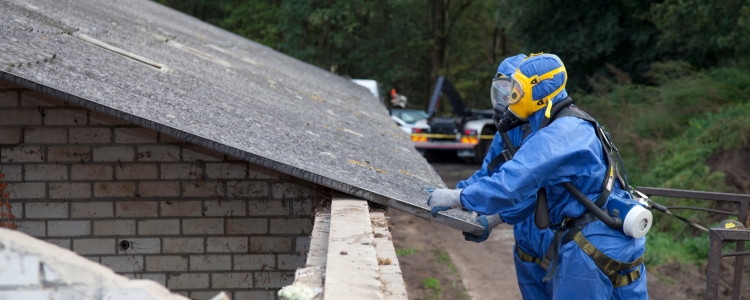
How to manage asbestos
Managing asbestos effectively starts with having a clear, accessible asbestos management plan (AMP). This essential document, which is required under the Control of Asbestos Regulations 2012, sets out who is responsible for managing asbestos, where asbestos is located in a building, what condition it is in, and how it will be managed safely over time.
For a detailed breakdown of what a robust AMP entails and how to create one, please read our guide: What is an asbestos management plan?
Stay compliant and safe with UKATA Asbestos Awareness Training
Knowing how many common types of asbestos were available and the differences between them is essential for duty holders. Under the Control of Asbestos Regulations 2012, those responsible for managing buildings, employing staff, or carrying out work that could disturb asbestos have legal duties to keep people safe.
Approved by the UK Asbestos Training Association (UKATA), our UKATA Asbestos Awareness eLearning course explains the different kinds of asbestos, their risks, and how to stay compliant with UK law. Find out more on our website or contact our friendly team today on 0203 011 4242 / info@praxis42.com to discuss how we can tailor course content to your employees and organisation.

Adam Clarke
Managing Director (Consulting)
